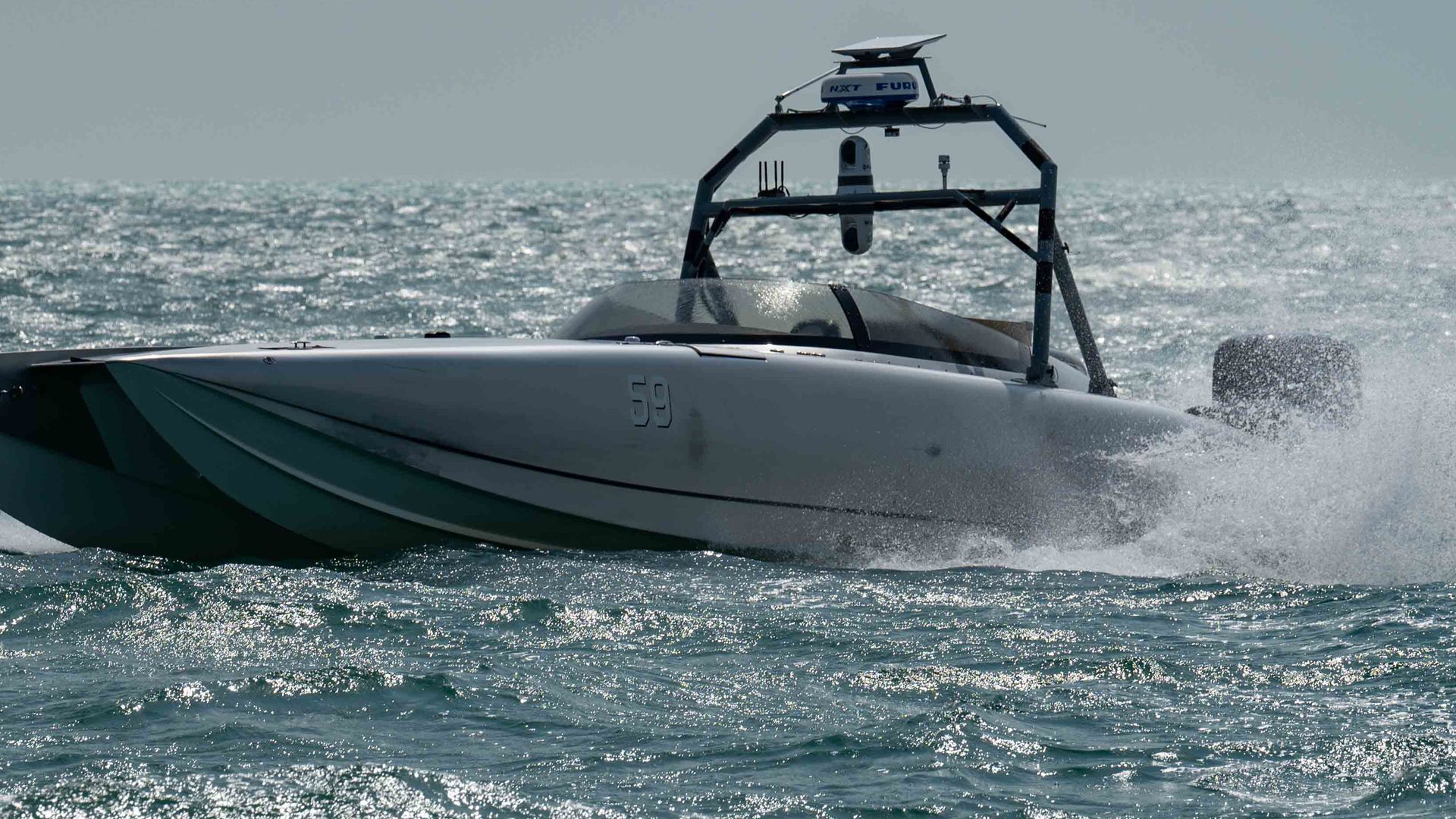
NAVY DRONE BOATS LAUNCHING LETHAL LOITERING MUNITIONS AT SEA. CONTAINERIZED MISSILES STRAPPED TO THE DECK OF STEALTHY SHIPS. THE NAVY IS LOOKING FOR WAYS TO BETTER COMPETE WITH NEAR PEER ADVERSARIES LIKE CHINA.
AT THE END OF OCTOBER, TASK FORCE 59, UNDER ORDERS FROM THE US NAVAL FORCES CENTRAL COMMAND, CONDUCTED LIVE-FIRE EXERCISES AROUND THE ARABIAN PENINSULA DURING EXERCISE DIGITAL TALON.
TASKFORCE 59, THE NAVY’S FIRST UNMANNED AND ARTIFICIAL INTELLIGENCE TASK FORCE, USED DEVIL RAY UNMANNED SURFACE VESSELS TO LAUNCH SEVERAL SMALL LOITERING MUNITIONS.
THE DEVIL RAYS LOOK LIKE A TYPICAL SPEED BOAT. THE 38-FOOT-LONG CRAFT CAN CARRY UP TO 4500 POUNDS AND REACH BURST SPEEDS GREATER THAN 60 KNOTS.
FOR DIGITAL TALON, THE NAVY EQUIPPED DEVIL RAYS WITH WHAT IT’S CALLING LETHAL MINIATURE AERIAL MISSILE SYSTEMS. FANS OF STRAIGHT ARROW NEWS MAY RECOGNIZE THE LAUNCH SYSTEM. IT LOOKS AN AWFUL LOT LIKE THE SELF-CONTAINED SYSTEM AEROVIRONMENT USES FOR ITS SWITCHBLADE 300 DRONES.
DURING MULTIPLE FIRING EVENTS, THE DEVIL RAY LAUNCHED AERIAL DRONES AT A DUMMY TARGET. THE DRONES HIT THEIR MARK WITH 100% ACCURACY. THE NAVY SAYS A HUMAN OPERATOR ON THE SHORE MADE THE ENGAGEMENT DECISIONS.
WHILE THE STOPPING POWER OF A SWITCHBLADE 300 ISN’T ENOUGH TO TAKE DOWN LARGE SHIPS, DEVIL RAYS ARMED WITH ESSENTIALLY GPS-GUIDED ROCKETS WILL OFFER NAVAL COMMANDERS GREATER FLEXIBILITY WHEN PLANNING OPERATIONS. THEY COULD BE USED AGAINST SMALLER SURFACE THREATS OR FOR COASTAL OPERATIONS.
FOR LARGER THREATS, WHEN MORE STOPPING POWER IS REQUIRED, SUPERSONIC MISSILES LIKE THE SM-6 ARE A BETTER OPTION. LARGER SHIPS LIKE DESTROYERS TYPICALLY CARRY SM-6 OR SIMILARLY SIZED-MISSILES, WHICH MAKES THEM PRIME TARGETS DURING A NAVAL ENGAGEMENT. TO DISTRIBUTE ITS FIREPOWER, THE NAVY IS EXPERIMENTING WITH PUTTING CONTAINERIZED MISSILE LAUNCHING SYSTEMS ON VARIOUS CRAFT.
WE ALREADY TOLD YOU ABOUT THE NAVY’S GHOST FLEET LAUNCHING CONTAINERIZED SM-6 MISSILES. NOW, IT LOOKS LIKE THE NAVY USED THE SAME MARK 70 PAYLOAD DELIVERY SYSTEM ON THE USS SAVANNAH, AN INDEPENDENCE-CLASS LITTORAL COMBAT SHIP WHICH JUST SO HAPPENS TO BE ONE OF THE SMALLEST SHIPS IN THE NAVY.
THE 40-FOOT-LONG LAUNCH SYSTEM LOOKS LIKE A REGULAR SHIPPING CONTAINER. BUT INSIDE, IT CAN HOLD UP TO FOUR SM-6 MISSILES CAPABLE OF DESTROYING CRUISE MISSILES, BALLISTIC MISSILES AND AIRCRAFT OUT TO 150 MILES.
PUTTING A MARK 70 PDS ON A LITTORAL COMBAT SHIP INSTANTLY INCREASES THE VESSEL’S FIREPOWER FAR-BEYOND ANYTHING IT CURRENTLY CARRIES, AND COULD OFFER NEW LIFE TO A CLASS OF VESSEL THAT HAS LARGELY UNDER-DELIVERED ON EXPECTATIONS.











